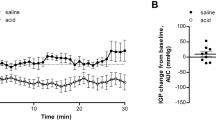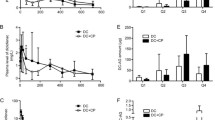Abstract
Adaptation occurs to the gastric injury produced by nonsteroidal antiinflammatory drugs during continued dosing. The aim of this study was to identify characteristics of this phenomenon that might help in the search for underlying mechanisms. The time frame for onset and offset of adaptation of diclofenac (damage assessed planimetrically) was examined in rats. Adaptation to oral diclofenac took three to five days to develop, and persisted for up to five days after the last dose. It was also demonstrable after subcutaneous dosing or when injury was measured by a change in mucosal potential difference. Diclofenac-adapted rats were protected against injury induced by subsequent exposure to ethanol, indomethacin, aspirin, or piroxicam, indicating that adaptation is not specific to injury by the adapting agent. This cross-adaptation was dose-dependent and characterized histologically by a reduction in deep damage. In conclusion, gastric adaptation to diclofenac is mediated by mechanisms that take several days to develop and be lost. The route of administration appears to be unimportant, but the development of both adaptation and cross-adaptation is influenced by dosage size.
Similar content being viewed by others
References
Hurley JW, Crandall LA: The effect of salicylates upon the stomachs of dogs. Gastroenterology 46:36–43, 1964
St John DJB, Yeomans ND, McDermott MB, de Boer WGRM: Adaptation of the rat gastric mucosa to repeated administration of aspirin in the rat. Am J Dig Dis 18:881–886, 1973
Graham DY, Smith JL, Dobbs SM: Gastric adaptation occurs with aspirin administration in man. Dig Dis Sci 28:1–6, 1983
Skeljo MV, Giraud A, Yeomans ND: Adaptation of rat gastric mucosa to repeated doses of non-salicylate non-steroidal anti-inflammatory drugs. J Gastroenterol Hepatol 7:586–590, 1992
Shorrock CJ, Prescott RJ, Rees WDW: The effects of indomethacin on gastroduodenal morphology and mucosal pH gradient in the healthy human stomach. Gastroenterology 99:334–339, 1990
Konturek SJ, Brzozowski T, Majika J, Drozdowicz D, Stachura J: Adaptation of the gastric mucosa to stress: Role of prostaglandin and epidermal growth factor. Scand J Gastroenterol 27(suppl 193):39–45, 1992
Tarnawski A, Lu S-Y, Stachura J, Sarfeh IJ: Adaptation of gastric mucosa to chronic alcohol administration is associated with increased mucosal expression of growth factors and their receptor. Scand J Gastroenterol 27(suppl 193):59–63, 1992
Konturek SJ, Brzozowski T, Stachura J, Dembinski A, Majika J: Role of gastric blood flow, neutrophil infiltration, and mucosal cell proliferation in gastric adaptation to aspirin in the rat. Gut 35:1189–1196, 1994
Shorrock DJ, Rees WDW: Mucosal adaptation to indomethacin induced gastric damage in man-studies on morphology, blood flow, and prostaglandin E2 metabolism. Gut 33:164–169, 1992
Romano M, Guglietta A, Lesch CA, Meise KS, Veljaca M, Sanchez B, Coffey RJ: Role of transforming growth factoralpha and epidermal growth factor in the gastric adaptation to aspirin in monkeys and rats. Gastroenterology 106:A836, 1994 (abstract)
Doljanin K, Skeljo MV, Giraud AS, Yeomans ND: Evidence of gastric adaptation to injury in rat antral mucosa in organ culture. J Gastroenterol Hepatol 9:A89, 1994 (abstract)
Lev R, Siegal HI, Jerzy Glass G: Effects of salicytlates on the canine stomach: A morphological and histochemical study. Gastroenterology 62:970–980, 1972
Robert A, Olafsson AS, Lancaster C, Zhang W: Mechanisms of gastric adaptation to necrotizing agents. Gastroenterology 100:A148, 1991 (abstract)
Wallace JL, McKnight GW: Gastric adaptation to aspirin is non-specific and prostaglandin-independent. Gastroenterology 104:A222, 1993 (abstract)
Read NW, Fordtran JS: The role of luminal junction potentials in the generation of the gastric potential difference in man. Gastroenterology 76:932–938, 1979
Welch BL: Further note on Mrs Aspin's tables and on certain approximations to the tabled function. Biometrika 36:293–296, 1949
Robert A, Lancaster C, Olafsson AS, Zhang W: Gastric adaptation to repeated administratio of a necrotizing agent.In Mechanisms of Injury, Protection and Repair of the Upper Gastrointestinal Tract. A Garner, PE O'Brien (eds). New York. John Wiley, 1991, pp 357–390
Brzozowski T, Majika T, Konturek SJ, Stachura J: Adaptation of the gastric mucosa to stress and aspirin. Role of sensory nerves, prostaglandins and epidermal growth factor. Gastroenterology 104:A48, 1993 (abstract)
Robert A, Nezamis JE, Lancaster C, Hanchar AJ: Cytoprotection by prostaglandins in rats. Prevention of gastric necrosis produced by EtOH, NaOH, hypertonic NaCl and thermal injury. Gastroenteroloy 77:433–443, 1979
Lacy ER, Ito S: Microscopic analysis of ethanol damage to rat gastric mucosa after treatment with a prostaglandin. Gastroenterology 83:619–625, 1982
Cook GA, Elliott SL, Skeljo MV, Giraud AS, Yeomans ND: Correlation between transmucosal potential difference and morphological damage during aspirin injury of gastric mucosa in rats. J Gastroenterol Hepatol 10:1995 (in press)
Pfeiffer CJ, Lewandowski LG: Comparison of gastric toxicity of acetylsalicylic acid with route of administration in the rat. Arch Int Pharmacodyn 190:5–13, 1971
Lanza FL, Royer GL Jr, Nelson RS: Endoscopic evaluation of the effects of aspirin, buffered aspirin, and enteric-coated aspirin on gastric mucosa. N Engl J Med 303:135–138, 1980
Drenska A, Ognyanova V, Tomov E, Mihailova D, Nakova G, Georgieva R, Dikova N: Feloran (diclofenac sodium) pharmacokinetics in experimental animals and humans after oral administration. Med Biol Inform 2:12–16, 1984
Author information
Authors and Affiliations
Additional information
Supported by a grant from the National Health and Medical Research Council of Australia.
Rights and permissions
About this article
Cite this article
Skeljo, M.V., Cook, G.A., Elliott, S.L. et al. Gastric mucosal adaptation to diclofenac injury. Digest Dis Sci 41, 32–39 (1996). https://doi.org/10.1007/BF02208581
Received:
Revised:
Accepted:
Issue Date:
DOI: https://doi.org/10.1007/BF02208581




